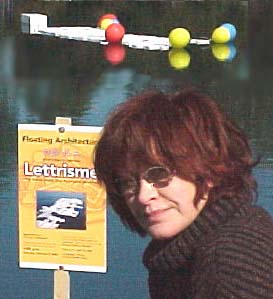

"Dès le début, ses créations plastiques présentées
pour la première fois au salon de Mai en 1971, apportaient à la
super-écriture, une structure inédite, basée sur des signes
personnels, massifs et arrondis, dont les
contours cernés correspondaient aux configurations particulères
résultant de définitions de lettres latines.
Ses agencements linéaires incorporent des détails inattendus, tant du
point de vue du traitement technique de l'ensemble de ses compositions,
que dans la délimitation formelle. Sur le premier plan, les
dégradés
subtils, délicats, la pastellisation de parties; sur le second plan, le
trait en pointillé, le remplissage des formes survenues par des données
idéographiques, semblent caractériser ces assemblages, dans
lesquels, de plus, et très régulièrement, des flèches
courent, comme pour indiquer à celui qui voudrait déchiffrer l'oeuvre,
des sens de lecture multiples et contradictoires." (Roland Sabatier, Le Lettrisme:
les créations et les
créateurs, Paris: Z'Editions, 1989)
Les réalisations photographiques, méca-esthétiques et architecturales de
cette artiste poursuivent également la même préoccupation de
multi-écritures. A ses alignements souples de graphies, dont certaines
restent non travaillées, créant un effet d'assonnces ou d'espace
infinitésimal, alors que d'autres sont enrichies de ponctuations
toniques, violentes ou estompées s'ajoutent, depuis 1989, l'apport
d'éléments mobiles et frémissants, réalisés
en bois et montés sur
ressorts: Signes à la fenêtre, Les plumes, Prélude au jardin.
Depuis 1994, ses installations flottantes et architectures dérivantes
matérialisent un concept de villes lacustres, telle une procession qui
pourrait se déplacer sur la mer, au gré de ses habitants.
Les volumes architecturaux sont matérialisés par l'effet
croisé de son alphabet hypergraphique qui laisse entrevoir de larges
avenues et places de communications ainsi que des complexes commerciaux et
culturels. Elle nous présente la ville du futur.
Cette démarche a été présentée la
première fois en 1994 au public Londonien de Hyde Park, puis de Regent's
Park, On the Serpentine, et Aquatic dance - ensuite, dans un
accomplissement plus élaboré au "Ruby Lake" du Georgia Southern
Museum de Statesboro, lors d'une grande manifestation lettriste
organisée par David Seaman: From Letters to
Lettrisme - the ancient origins of an avant-garde movement.
|
|
"The creations that she exhibited for the first time at the Salon de
Mai in 1971 brought to super-writing a new structure based on massive
and rounded personal signs whose hard-edged contours correspond to the
specific shapes defined by Latin letters. Her linear arrangements
incorporate unexpected details, both in the technical treatment of the
overall design, and in the formal elements. Subtle, delicate and pastel
shadings in the foreground give way to pointillated markings in the
background which fill up forms that come from ideographic sources.
Running through these assemblages are arrows which seem to suggest
multiple and contradictory readings to anyone interpreting the works."
(Roland Sabatier, Le Lettrisme: Les Créations et les Créateurs. Z
Editions, 1989.)
The photographic, meca-aesthetic, and architectural works of this artist
also follow the same preoccupation with multiple-writing. Her supple and
graphic alignments, some of which remain unworked, create an effect of
resonance or infinite space, while others are enriched with accented
punctuation, either violent or blurred. Since 1989, she has added mobile
and shimmering elements, created in wood and connected with springs,
such as "Signs at the window," "Feathers," and "Prelude to the Garden."
Roehmer participated in the Manifeste pour la renovation de
I'architecture, in 1992, where she proposed a three-dimensional model of
a "Maison individuelle," here extending her familiar signs with legs and
nose to a "head" with spring-loaded antennae; as a house design
suggesting in her ludic style a penthouse - possibly a gymnasium or
solarium--in the sky. In 1994 she began creating floating sculptures and
related architectural plans leading to a concept of cities for
lake-dwellers, as if it were a procession which couldfloat around at the
will of its inhabitants.
In 1994 she began creating floating sculptures and related
architectural plans leading to a concept of cities for lake-dwellers,
such as a procession which could float around at the will of its
inhabitants.
The architectural volumes are given shape by her personal hypergraphic
alphabet which reveals broad avenues and community spaces, crossed by
commercial and cultural complexes. She presents us with the city of the
future.
This process was first presented to a London audience in 1994 at Hyde
Park, then in Regent's Park, with "On the Serpentine" and "Aquatic
Dance," then in a more elaborate version on Ruby Lake in Statesboro,
Georgia, as part of the exhibition, From Letters to Lettrisme - the
Ancient Origins of an Avant-Garde Movement, at the
Georgia Southern Museum in 2000.
|
Return to Kaldron | Light and Dust
This is a cooperative publication of
Kaldron On-Line and
Light and Dust Mobile Anthology of Poetry